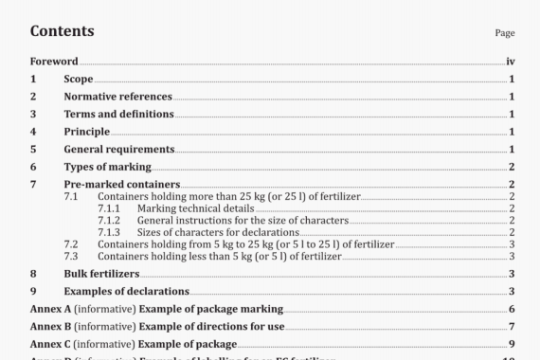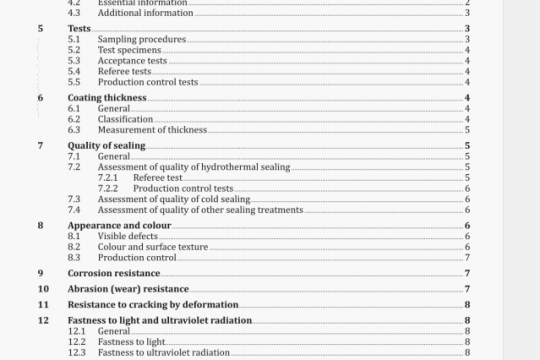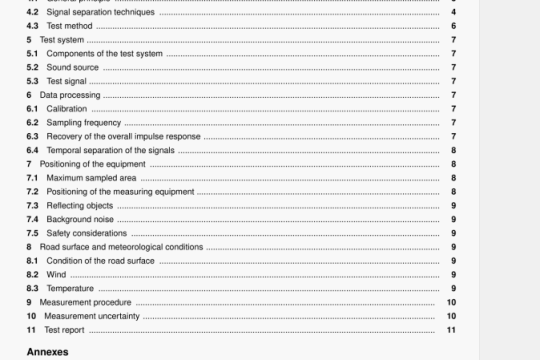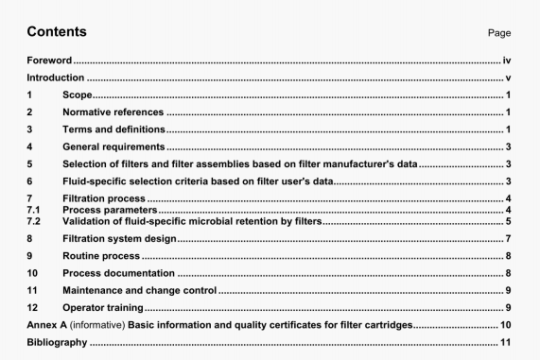ISO 105-C09:2001 pdf download
ISO 105-C09:2001 pdf download.Textiles – Tests for colour fastness 一Part co9: Colour fastness to domestic andcommercial laundering -Oxidative bleach response using a non-phosphatereference detergent incorporating a low temperature bleach activator.
This part of ISO 105 specifies a method for determining the consumer relevant shade change of textiles, of all kinds, (excluding silk and wool) and in all forms, to domestic/commercial laundering procedures in which a bleach activator (oxygen bleaching system) is used.
The colour fastness resulting from oxygen bleaching in this test provides an indication of the shade change behaviour observed after multiple domestic/commercial launderings.
This part of ISO 105 is not applicable for the assessment of the dye staining of adjacent fabrics, where suitable methods are described in ISO 105-A04.
This part of ISO 105 does not reflect the contribution of optical brighteners, which are present in some commercial washing products, to shade change.
This part of ISO 105 specifies a procedure incorporating the use of ECE1 non-phosphate reference detergent, sodium perborate tetrahydrate, and the bleach activator tetra-acetylethylenediamine (TAED). An alternative test procedure using the AATCC 1993 zero phosphate reference detergent (without optical brightener), and incorporating sodium perborate monohydrate and the bleach activator sodium nonanoyloxybenzene sulphonate (SNOBS) is currently under development.
2 Normative references
The following normative documents contain provisions which, through reference in this text, constitute provisions of this part of ISO 105. For dated references, subsequent amendments to, or revisions of, any of these publications do not apply. However, parties to agreements based on this part of ISO 105 are encouraged to investigate the possibility of applying the most recent editions of the normative documents indicated below. For undated references, the latest edition of the normative document referred to applies. Members of ISO and IEC maintain registers of currently valid International Standards.
ISO 105-AOl :1994, Textiles — Tests for colour fastness — Part AOl: General principles of testing
ISO 1 05-A02: 1993, Textiles — Tests for colour fastness — Part A02: Grey scale for assessing change in colour
ISO 1 05-A05:1 996, Textiles — Tests for colour fastness — Part A05: Instrumental assessment of change in colour for determination of grey scale rating
ISO 1 05-JO 1:1997, Textiles — Tests for colour fastness — Part JOl: General principles for measurement of surface colour
Iso 1 05-J03:1 995, Textiles — Tests for colour fastness — Part J03: Calculation of colour differences ISO 3696:1987, Water for analytical laboratory use — Specification and test methods
3 Principle
A specimen of the textile is laundered, rinsed and dried. Specimens are laundered under specified conditions of temperature, alkalinity and bleach concentration such that a fading result which correlates with a multicycle machine washing is obtained in a conveniently short time. The change in colour of the specimen is assessed with reference to the original fabric, either with the grey scale or instrumentally.
4 Reagents and materials
4.1 Reference detergent.
4.1.1 ECE non-phosphate reference detergent base powder (1998 formulation).
4.1.2 Bleach activator, tetra-acetylethylenediamine, TAED.
4.1.3 Sodium perborate tetrahydrate.
4.2 Grade 3 water, complying with ISO 3696.
4.3 Grey scale, for assessing change in colour complying with ISO 105-A02 or a spectrophotometer for assessing change in colour complying with ISO 105-JO 1.
4.4 FIlter papers.
5 Apparatus
5.1 Suitable mechanical laundering device, consisting of a water bath containing a rotatable shaft which
supports, radially, stainless steel containers (75 mm ± 5 mm diameter x 125 mm ± 10mm high) of capacity
(550 ± 50) ml, the bottom of the containers being (45 ± 10) mm from the centre of the shaft. The shaft/container
assembly is rotated at a frequency of (40 ± 2) min1. The temperature of the water bath is thermostatically
controlled to maintain the test solution at the prescribed temperature ± 2 °C.
Other mechanical devices may be used for this test, provided that the results are identical with those obtained by the apparatus described in 5.1.
5.2 Balance, accurate to ± O,Olg (see ISO 105-AOl).
5.3 Mechanical Stirrer, minimum 16,667s1 (1 000 rpm) to ensure thorough dispersion and prevent settling.
6 Test specimen
6.1 If the textile to be tested is fabric, cut a 50 mm x 100 mm piece.
6.2 Yarn may be knitted into fabric of dimensions 50 mm x 100 mm, and tested in this form. Alternatively, for yarns and threads, form a wick of parallel lengths 100 mm long and about 5 mm in diameter. Determine the mass of the specimen and either tie both ends or sew on to a piece of polypropylene backing cloth (50 mm x 100 mm) as support. In the latter case, only the mass of yarns and threads are taken to determine the liquor ratio volumes.
6.3 Determine the mass, in grams, of the specimen using the balance (5.2), to aid accurate liquor ratio volumes.




